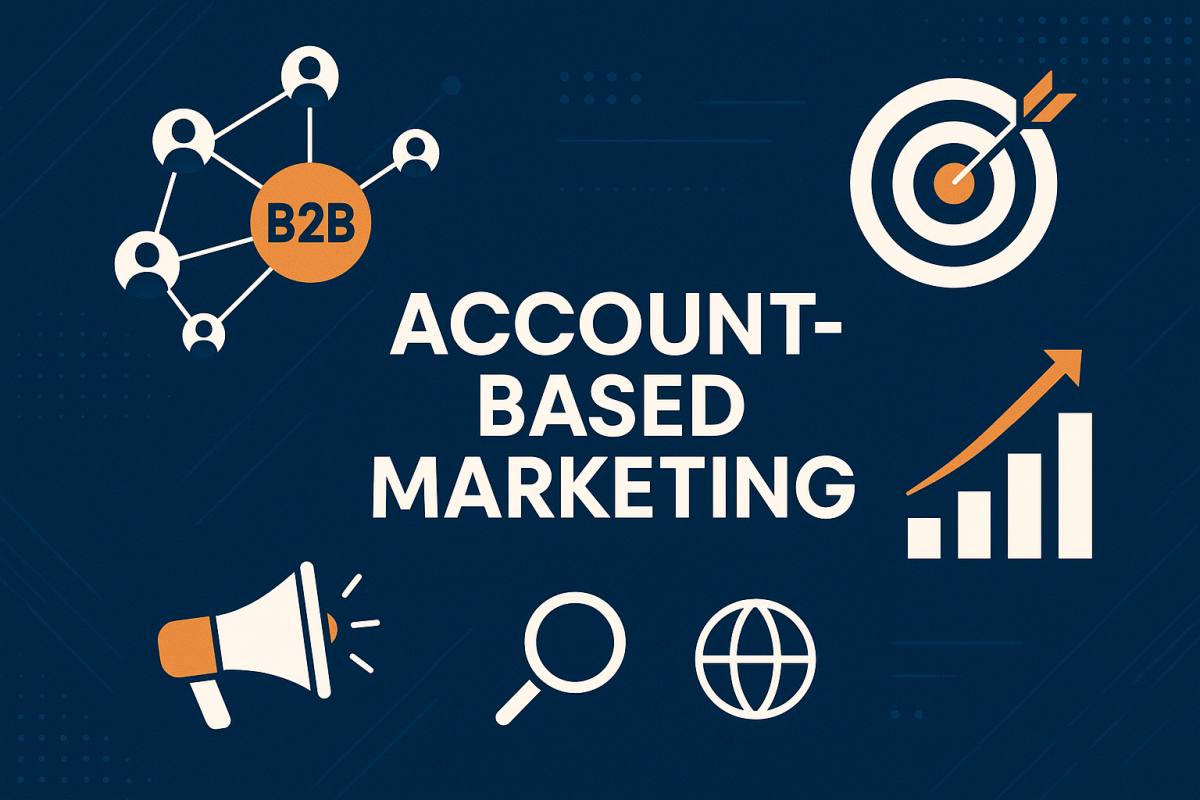Account-based marketing (ABM) has emerged as the most effective B2B marketing strategy, with 81% of organizations reporting higher ROI compared to traditional marketing approaches. Recent research from Forrester reveals that companies implementing ABM strategies see 21-50% higher returns, while 23% achieve even more dramatic improvements of 51-200% higher ROI. This comprehensive guide examines the evidence-based best practices that separate successful ABM programs from underperforming initiatives, drawing on authoritative research from leading institutions including Forrester, ITSMA, and HubSpot.
The Strategic Context of Account-Based Marketing in 2025
The B2B marketing landscape has undergone a fundamental transformation, driven by economic pressures, technological advancement, and evolving buyer behaviors. Account-based marketing has emerged not merely as a tactical approach, but as a strategic imperative for organizations seeking sustainable growth in an increasingly competitive marketplace.
According to ITSMA’s Global Account-Based Marketing Benchmark study, which surveyed over 300 B2B marketers in 2024/25, 90% of organizations now have active ABM programs [1]. This widespread adoption reflects a critical shift from volume-based marketing approaches to precision-targeted strategies that focus on high-value accounts. The economic context driving this transformation cannot be understated: as HubSpot’s “Not Another State of Marketing Report” indicates, 70% of marketers now have active account-based marketing programs in place, largely due to economic pressures that demand more efficient resource allocation [2].
The effectiveness of ABM becomes particularly evident when examining ROI data from authoritative sources. Forrester’s 2024 research, “Account-Based Marketing Delivers Higher ROI Across Regions,” provides compelling evidence that ABM programs consistently outperform traditional marketing approaches across North America, Europe, and Asia Pacific. The study reveals that most ABM decision-makers report their programs yield 21% to 50% higher ROI, with a notable 23% of global respondents reporting ROI improvements of 51% to 200% [3]. This data demonstrates the universal applicability of ABM strategies, regardless of regional market conditions or cultural contexts.
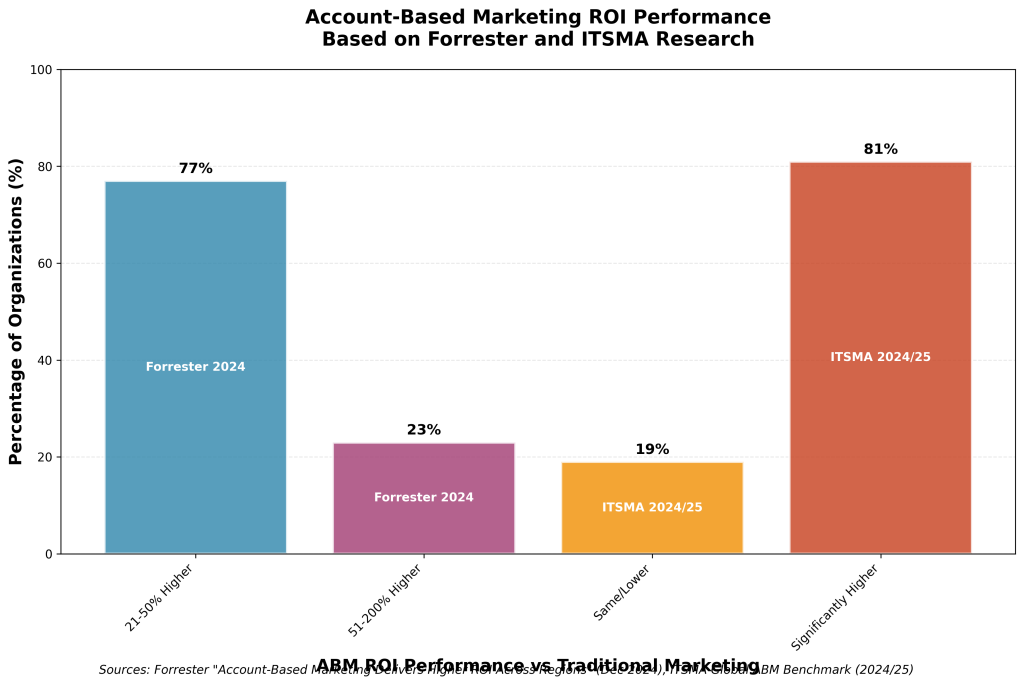
The strategic importance of ABM extends beyond immediate ROI improvements. Research indicates that organizations implementing ABM strategies experience fundamental improvements in their go-to-market effectiveness. RollWorks’ comprehensive analysis of ABM statistics reveals that companies aligning ABM with Account-Based Advertising see 60% higher win rates, while ABA campaigns increase customer engagement by 72% [4]. These metrics underscore ABM’s role in creating more meaningful, productive interactions with target accounts.
However, the current economic environment presents both opportunities and challenges for ABM implementation. The same economic pressures that drive organizations toward more targeted marketing approaches also constrain budgets and resources. This paradox requires organizations to be more strategic in their ABM investments, focusing on approaches that deliver measurable results while maintaining operational efficiency. The most successful ABM programs, according to ITSMA research, are those that view ABM not as a standalone tactic but as an integrated approach that enriches all marketing activities.
The technological landscape supporting ABM has also evolved significantly. Advanced analytics, artificial intelligence, and marketing automation platforms now enable more sophisticated account targeting, personalization, and measurement capabilities. Yet this technological advancement comes with its own challenges: organizations must navigate an increasingly complex vendor landscape while ensuring their technology investments align with their strategic ABM objectives.
Understanding this context is crucial for organizations considering ABM implementation or seeking to optimize existing programs. The evidence clearly demonstrates that ABM is not a temporary trend but a fundamental shift in B2B marketing strategy. Organizations that fail to adapt risk being left behind by competitors who embrace more targeted, account-centric approaches to market engagement.
Evidence-Based ABM Framework and Implementation
Successful account-based marketing implementation requires a structured framework that balances strategic vision with tactical execution. Research from leading institutions reveals that the most effective ABM programs follow a systematic approach that addresses five critical components: account identification, sales-marketing alignment, personalized content creation, multi-channel engagement, and performance measurement.
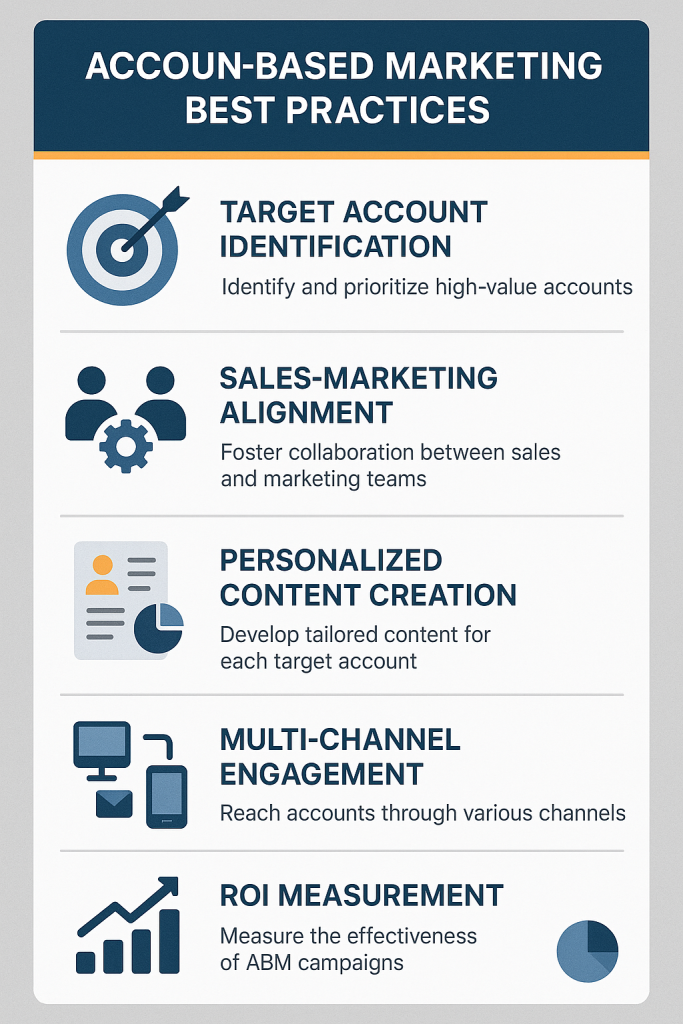
The Three-Tier ABM Model
ITSMA’s research demonstrates that 60% of organizations implement more than one type of ABM, utilizing a three-tier approach that optimizes resource allocation across different account segments [1]. This multi-tiered strategy allows organizations to scale their ABM efforts while maintaining the personalization that drives effectiveness.
| ABM Tier | Account Volume | Personalization Level | Resource Investment | Typical Use Case |
|---|---|---|---|---|
| One-to-One ABM | 1-5 accounts | Highly customized | High | Strategic enterprise accounts |
| One-to-Few ABM | 5-20 accounts | Semi-customized | Medium | Industry or segment clusters |
| One-to-Many ABM | 20+ accounts | Scaled personalization | Lower per account | Broader market segments |
The three-tier model enables organizations to optimize their ABM investments by matching resource intensity with account potential. One-to-one ABM focuses on the highest-value strategic accounts that justify significant personalized investment. One-to-few ABM targets account clusters with shared characteristics, allowing for semi-customized approaches that balance personalization with efficiency. One-to-many ABM applies ABM principles to larger account sets, using technology and automation to deliver scaled personalization.
Technology Integration and Platform Selection
The technology foundation supporting ABM implementation has become increasingly sophisticated, yet organizations must carefully evaluate their platform choices to ensure alignment with strategic objectives. HubSpot’s research indicates that successful ABM implementation requires integration between marketing automation, CRM systems, and specialized ABM platforms [5]. The most effective implementations create a unified technology stack that enables seamless data flow and coordinated campaign execution across all customer touchpoints.
However, technology selection presents significant challenges. Organizations often struggle with platform proliferation, where multiple point solutions create data silos and operational complexity. The most successful ABM programs prioritize integration capabilities and data quality over feature richness, recognizing that consistent, accurate account intelligence is more valuable than sophisticated functionality operating on incomplete data.
Account Intelligence and Data Foundation
ITSMA’s research reveals a critical performance differentiator: 39% of ABM leaders fully leverage account intelligence, compared to only 25% of laggards [1]. This gap highlights the importance of comprehensive account research and data management in driving ABM success. Effective account intelligence encompasses firmographic data, technographic insights, intent signals, and stakeholder mapping.
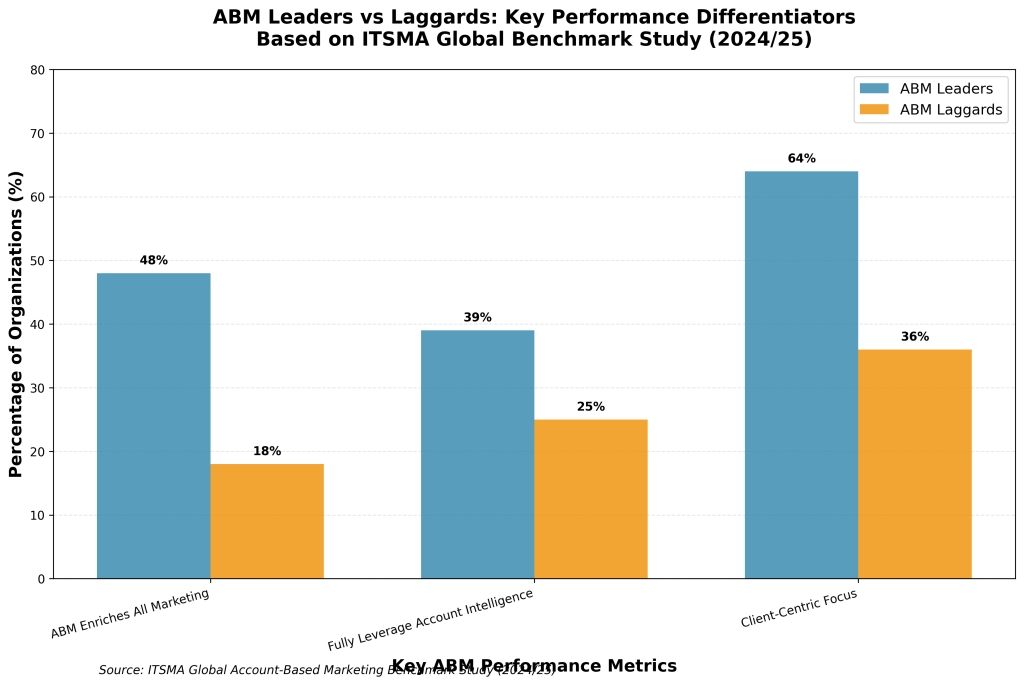
The account intelligence foundation must extend beyond basic company information to include behavioral data, engagement history, and predictive insights. Organizations that excel at ABM invest in data quality processes, ensuring that account information remains current and actionable. This investment in data foundation pays dividends throughout the ABM lifecycle, enabling more precise targeting, relevant messaging, and accurate performance measurement.
Content Strategy and Asset Development
Personalized content creation represents one of the most resource-intensive aspects of ABM implementation, yet it is also one of the most critical success factors. Research indicates that effective ABM content strategies balance scalability with relevance, creating content frameworks that can be efficiently customized for different account tiers and stakeholder personas.
The most successful ABM programs develop content libraries organized around account challenges, industry contexts, and buying stage requirements. This approach enables rapid content customization while maintaining message consistency and brand standards. Organizations that struggle with ABM content often attempt to create entirely unique content for each account, leading to resource constraints and delayed campaign execution.
Sales and Marketing Alignment: The Foundation of ABM Success
The relationship between sales and marketing teams fundamentally determines ABM program effectiveness. Unlike traditional marketing approaches where handoffs between teams can be managed through lead scoring and qualification processes, ABM requires continuous collaboration and shared accountability for account outcomes. Research consistently identifies sales-marketing alignment as the primary differentiator between successful and struggling ABM implementations.
HubSpot’s comprehensive ABM research emphasizes that account-based marketing “keeps marketing and sales aligned” in ways that might not be possible with other approaches [5]. This alignment manifests in several critical areas: shared account selection criteria, coordinated messaging strategies, integrated campaign execution, and unified performance metrics. Organizations that achieve this alignment report significantly higher ABM effectiveness and ROI.
Shared Account Selection and Prioritization
The foundation of sales-marketing alignment in ABM begins with collaborative account selection processes. Traditional marketing approaches often rely on marketing-generated leads that sales teams may or may not prioritize. ABM inverts this dynamic, requiring both teams to agree on target accounts before any campaign development begins.
Effective account selection processes involve joint evaluation of account potential, fit, and accessibility. Sales teams contribute insights about account relationships, competitive positioning, and buying process complexity. Marketing teams provide data-driven analysis of account engagement patterns, digital behavior, and content consumption. This collaborative approach ensures that ABM investments focus on accounts where both teams can contribute effectively to success.
However, achieving consensus on account selection often reveals underlying tensions between sales and marketing priorities. Sales teams may favor accounts with immediate opportunity potential, while marketing teams might prioritize accounts with strong digital engagement signals. The most successful ABM programs establish clear criteria that balance short-term opportunity with long-term account development potential.
Coordinated Messaging and Content Strategy
Sales-marketing alignment in ABM extends beyond account selection to encompass coordinated messaging strategies that ensure consistent account experiences across all touchpoints. This coordination requires both teams to understand account-specific value propositions, competitive differentiators, and stakeholder concerns.
Research from RollWorks demonstrates the impact of coordinated approaches: companies that align ABM with Account-Based Advertising see 60% higher win rates [4]. This improvement stems from consistent messaging that reinforces key themes across digital advertising, sales conversations, and marketing content. When prospects encounter aligned messages across multiple channels, they develop stronger confidence in the vendor’s understanding of their needs and challenges.
Implementing coordinated messaging requires structured communication processes between sales and marketing teams. Regular account planning sessions, shared content repositories, and integrated campaign calendars help ensure that both teams understand and support unified account strategies. Organizations that struggle with ABM often discover that sales and marketing teams are delivering conflicting messages to the same accounts, undermining credibility and effectiveness.
Integrated Campaign Execution
The execution phase of ABM campaigns reveals the true strength of sales-marketing alignment. Unlike traditional campaigns where marketing generates leads and sales follows up, ABM campaigns require coordinated activities that blend digital marketing, direct sales engagement, and account-based experiences.
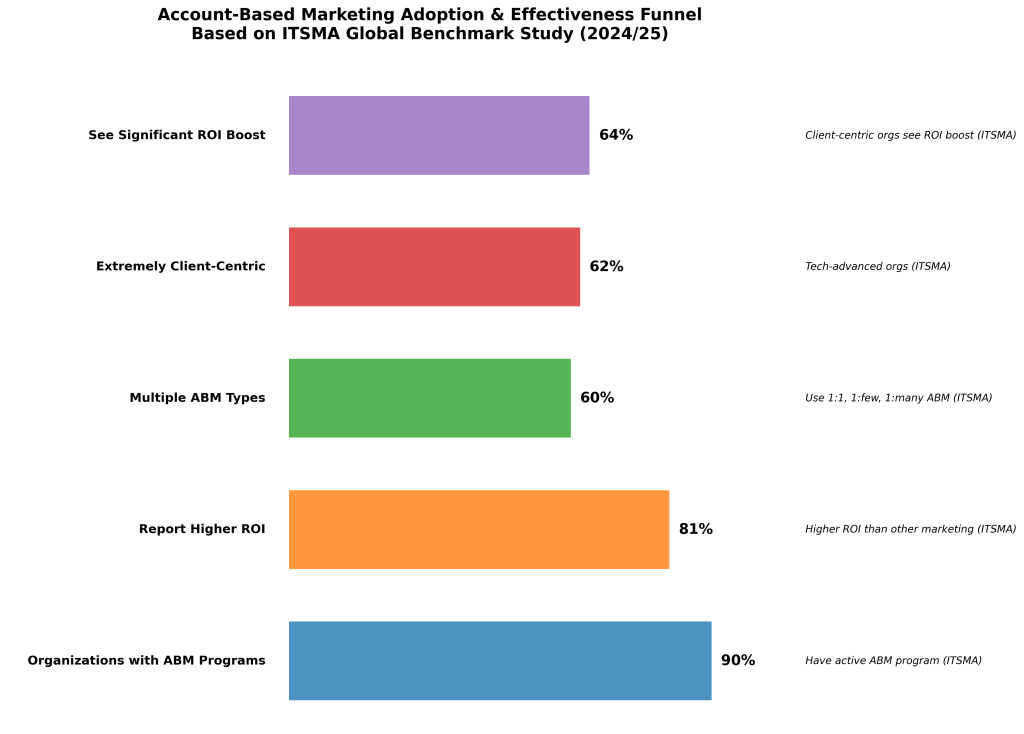
Successful integrated execution often involves synchronized activities such as coordinated email sequences that combine marketing automation with personalized sales outreach, event strategies that blend digital promotion with sales-driven attendance, and content campaigns that support ongoing sales conversations. This level of coordination requires sophisticated planning and communication processes that many organizations find challenging to implement.
The complexity of integrated execution explains why ITSMA research shows that 48% of ABM leaders say ABM enriches all their marketing activity, compared to only 18% of laggards [1]. Leaders understand that ABM is not a separate marketing channel but an integrated approach that transforms how all marketing activities support account development.
Unified Performance Metrics and Accountability
Traditional sales and marketing organizations often operate with different performance metrics that can create conflicting incentives. Marketing teams may focus on lead generation volume and cost per lead, while sales teams prioritize conversion rates and deal size. ABM requires both teams to adopt shared metrics that reflect account-level outcomes rather than individual team contributions.
Effective ABM metrics include account engagement scores that combine digital and sales interactions, pipeline velocity measurements that track account progression across the entire buying journey, and revenue attribution models that recognize both marketing and sales contributions to account success. These unified metrics create shared accountability for account outcomes and encourage collaborative behavior.
However, implementing unified metrics often requires significant organizational change. Compensation structures, performance reviews, and team objectives may need adjustment to support collaborative ABM approaches. Organizations that successfully implement these changes report stronger team collaboration and improved ABM outcomes, while those that maintain separate metrics often struggle with team conflicts and suboptimal results.
Organizational Structure and Governance
The organizational implications of sales-marketing alignment extend beyond process changes to encompass structural considerations. Some organizations create dedicated ABM teams that include both sales and marketing professionals. Others maintain separate teams but implement strong governance processes that ensure coordination and accountability.
Research suggests that organizational structure is less important than governance effectiveness. Organizations with strong ABM governance processes, regular cross-team communication, and clear escalation procedures achieve better alignment regardless of their structural approach. The key is ensuring that both teams have clear roles, shared objectives, and regular opportunities for collaboration and feedback.
Strategic Account Selection and Prioritization
Account selection represents the most critical decision in ABM implementation, as it determines the foundation upon which all subsequent activities build. Unlike traditional marketing approaches that cast wide nets to capture as many prospects as possible, ABM requires precise account identification that balances opportunity potential with resource constraints. The quality of account selection decisions directly impacts program ROI and long-term success.
Effective account selection combines quantitative analysis with qualitative insights to identify accounts that offer the highest probability of success. This process typically involves multiple evaluation criteria including account fit, opportunity potential, accessibility, and strategic value. Organizations that excel at account selection develop systematic approaches that can be consistently applied and refined over time.
Account Scoring and Prioritization Models
The most sophisticated ABM programs employ multi-dimensional scoring models that evaluate accounts across several key criteria. These models typically include firmographic factors such as company size, industry, and growth trajectory, alongside behavioral indicators such as digital engagement, content consumption, and website activity. Intent data, when available, provides additional insights into account interest and buying stage.
| Scoring Dimension | Key Factors | Data Sources | Weight Range |
|---|---|---|---|
| Fit Score | Industry, size, technology stack, geography | CRM, third-party data, technographic tools | 25-35% |
| Intent Score | Content consumption, search behavior, competitor research | Intent data providers, website analytics | 20-30% |
| Engagement Score | Website visits, email opens, event attendance | Marketing automation, event platforms | 15-25% |
| Relationship Score | Existing connections, referral potential, partnership status | CRM, LinkedIn, sales team input | 15-25% |
However, scoring models must be regularly calibrated based on actual results. Accounts that score highly but fail to engage may indicate model deficiencies that require adjustment. Similarly, accounts that exceed expectations despite lower scores provide insights into factors that may be underweighted in the current model. The most effective ABM programs treat account scoring as an iterative process that improves over time.
Account Accessibility and Competitive Analysis
Account potential means little if the account is inaccessible or dominated by entrenched competitors. Accessibility assessment involves evaluating existing relationships, competitive positioning, and account openness to new vendors. This analysis often requires input from sales teams who understand account dynamics and competitive landscapes.
Competitive analysis in ABM extends beyond traditional competitor identification to encompass status quo bias and internal solution development. Many high-potential accounts may not be actively evaluating external solutions, preferring to maintain existing approaches or develop internal capabilities. Understanding these dynamics helps prioritize accounts where external solutions are more likely to be considered.
Personalization at Scale: Content and Campaign Strategies
Personalization represents the core value proposition of account-based marketing, yet it also presents the greatest operational challenge. Effective ABM personalization goes beyond inserting company names into email templates to encompass deep customization of messaging, content, and experiences based on account-specific insights and stakeholder needs.
The challenge lies in achieving meaningful personalization while maintaining operational efficiency. Organizations that attempt to create entirely unique content for each account quickly encounter resource constraints that limit program scale. Conversely, organizations that rely on minimal personalization fail to differentiate their ABM efforts from traditional marketing approaches.
Content Framework and Template Development
Successful ABM personalization relies on structured content frameworks that enable efficient customization while maintaining message relevance. These frameworks typically organize content around account challenges, industry contexts, and stakeholder personas, creating modular components that can be combined and customized for specific accounts.
The framework approach allows organizations to develop core content assets that address common account needs while providing customization points for account-specific details. For example, a case study template might include industry-specific challenges, solution approaches, and outcome metrics that can be tailored for different account contexts without requiring complete content recreation.
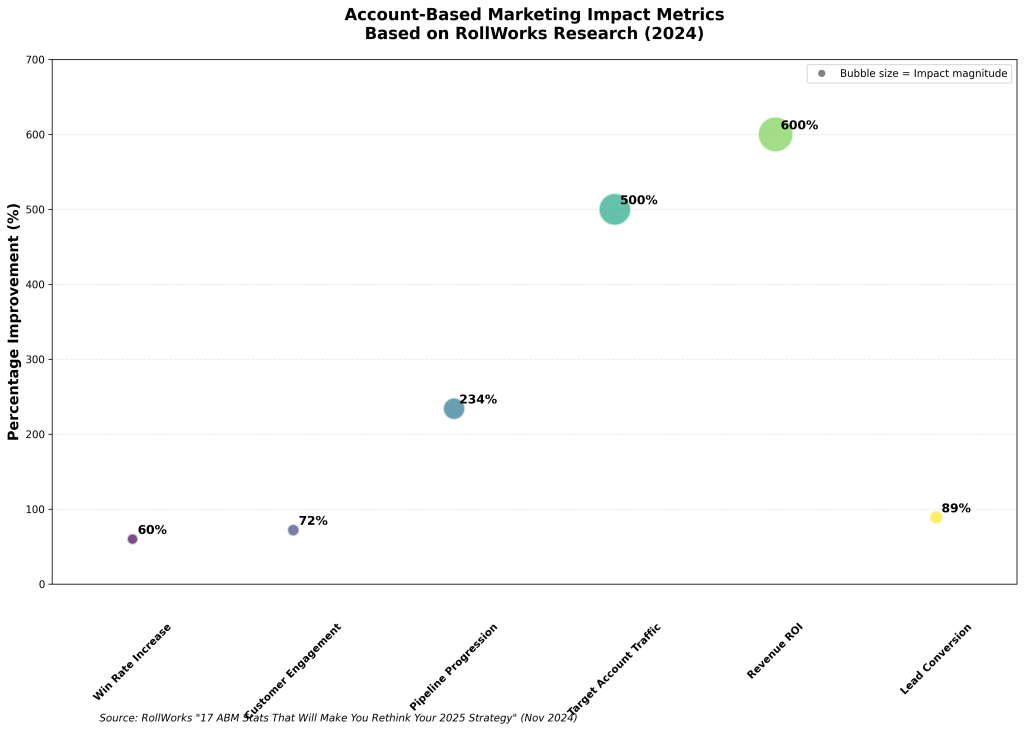
Content frameworks also support consistency across different content types and channels. When sales teams, marketing campaigns, and digital experiences draw from the same framework, accounts encounter consistent messaging that reinforces key themes and value propositions. This consistency is particularly important in complex B2B buying processes where multiple stakeholders evaluate solutions over extended timeframes.
Stakeholder-Specific Messaging Strategies
B2B buying decisions typically involve multiple stakeholders with different priorities, concerns, and information needs. Effective ABM personalization addresses these differences through stakeholder-specific messaging that speaks to individual roles while supporting overall account objectives.
Research from RollWorks indicates that 75% of B2B marketers using ABM are able to engage with the right buyers earlier in their buying process [4]. This early engagement advantage stems from personalized approaches that address stakeholder-specific concerns rather than generic value propositions that may not resonate with individual decision-makers.
Stakeholder personalization requires detailed persona development that goes beyond demographic information to encompass role-specific challenges, success metrics, and decision-making criteria. Technical stakeholders may prioritize integration capabilities and security features, while business stakeholders focus on ROI and strategic alignment. Effective ABM messaging addresses these different priorities through tailored content and communication approaches.
Multi-Channel Orchestration
ABM personalization extends across multiple channels and touchpoints, requiring orchestrated approaches that deliver consistent experiences regardless of how accounts engage. This orchestration involves coordinating digital advertising, email marketing, social media, direct mail, events, and sales outreach to create cohesive account experiences.
The complexity of multi-channel orchestration explains why many ABM programs struggle with execution. Each channel has different capabilities, limitations, and optimization requirements. Digital advertising may enable broad reach but limited personalization depth, while direct mail allows high personalization but limited scale. Successful ABM programs understand these trade-offs and design channel strategies that leverage each channel’s strengths while compensating for limitations.
Channel orchestration also requires sophisticated timing and sequencing strategies. Accounts may need different message sequences based on their engagement patterns and buying stage. Early-stage accounts might receive educational content through digital channels, while late-stage accounts receive detailed solution information through sales-supported channels. Managing these complex sequences requires robust campaign management capabilities and close sales-marketing coordination.
ROI Measurement and Performance Analytics
Measuring ABM effectiveness requires sophisticated analytics approaches that capture account-level outcomes rather than traditional lead-based metrics. The complexity of B2B buying processes, extended sales cycles, and multiple stakeholder involvement creates measurement challenges that many organizations struggle to address effectively.
ITSMA research reveals that 81% of organizations report that ABM delivers higher ROI than other marketing activities [1], yet many struggle to quantify this performance advantage through systematic measurement approaches. The challenge lies in developing metrics that accurately reflect ABM’s impact on account development, pipeline acceleration, and revenue generation.
Account-Level Metrics and KPIs
Traditional marketing metrics such as cost per lead and lead conversion rates provide limited insight into ABM effectiveness. Account-based marketing requires metrics that reflect account engagement, relationship development, and buying process progression. These metrics must capture both marketing and sales contributions to account success.
| Metric Category | Key Metrics | Measurement Approach | Success Indicators |
|---|---|---|---|
| Account Engagement | Engagement score, stakeholder reach, content consumption | Multi-channel activity tracking | Increasing engagement breadth and depth |
| Pipeline Impact | Pipeline velocity, deal size, win rate | CRM analysis and cohort comparison | Faster progression, larger deals |
| Revenue Attribution | Influenced revenue, ROI, customer lifetime value | Multi-touch attribution modeling | Positive ROI, increased CLV |
| Relationship Quality | Stakeholder mapping, relationship strength, advocacy | Sales team assessment, survey data | Deeper relationships, referrals |
Effective ABM measurement requires baseline establishment and cohort analysis to isolate ABM impact from other factors. Organizations should compare ABM account performance against control groups or historical performance to quantify improvement. This analysis becomes particularly important when justifying ABM investments and optimizing program approaches.
Attribution Modeling and Revenue Impact
Revenue attribution in ABM presents unique challenges due to long sales cycles and multiple touchpoint interactions. Traditional first-touch or last-touch attribution models fail to capture the cumulative impact of sustained ABM engagement across extended buying processes.
Multi-touch attribution models provide more accurate insights into ABM revenue impact, but they require sophisticated data integration and analysis capabilities. Organizations must track account interactions across multiple channels and touchpoints, then apply statistical models to estimate each interaction’s contribution to eventual outcomes.
The complexity of attribution modeling explains why many organizations struggle to demonstrate ABM ROI despite experiencing improved results. Investing in attribution capabilities and measurement infrastructure often represents a significant portion of ABM program costs, yet this investment is essential for program optimization and stakeholder buy-in.
Implementation Challenges and Risk Mitigation
Despite its proven effectiveness, ABM implementation presents significant challenges that organizations must address to achieve success. Understanding these challenges and developing mitigation strategies is essential for organizations considering ABM adoption or seeking to optimize existing programs.
Research consistently identifies several common implementation challenges: resource constraints, technology complexity, measurement difficulties, and organizational alignment issues. Organizations that proactively address these challenges achieve better ABM outcomes than those that underestimate implementation complexity.
Resource Allocation and Scalability Constraints
ABM’s emphasis on personalization and account-specific approaches creates inherent scalability challenges. Organizations often struggle to balance the depth of personalization required for effectiveness with the breadth of coverage needed for meaningful business impact. This tension becomes particularly acute in organizations with limited marketing resources or aggressive growth targets.
The resource challenge manifests in several areas: content creation demands, campaign management complexity, and sales team coordination requirements. Each ABM account requires dedicated attention and customized approaches that consume more resources than traditional marketing programs. Organizations that fail to account for these resource requirements often experience program delays and suboptimal results.
Effective resource management requires careful account prioritization and tiered service models that match resource investment with account potential. Organizations should resist the temptation to apply one-to-one ABM approaches to all target accounts, instead developing scalable frameworks that enable efficient personalization across different account tiers.
Technology Integration and Data Quality Issues
ABM success depends heavily on technology infrastructure that enables account identification, engagement tracking, and campaign orchestration. However, many organizations struggle with technology integration challenges that limit ABM effectiveness.
Common technology challenges include data silos between marketing and sales systems, incomplete account intelligence, and limited attribution capabilities. These issues prevent organizations from developing comprehensive account views and measuring program effectiveness accurately.
Addressing technology challenges often requires significant investment in platform integration, data quality processes, and analytics capabilities. Organizations should prioritize technology investments that support their specific ABM objectives rather than pursuing comprehensive solutions that may exceed their needs and capabilities.
Organizational Change Management
ABM implementation often requires significant organizational changes that extend beyond marketing team processes. Sales team collaboration, performance metrics, and compensation structures may need adjustment to support ABM approaches effectively.
Resistance to change represents a common implementation challenge, particularly in organizations with established sales and marketing processes. Team members may be reluctant to adopt new approaches that require additional coordination and different success metrics.
Successful change management requires clear communication about ABM benefits, comprehensive training programs, and gradual implementation approaches that allow teams to adapt over time. Organizations that attempt rapid ABM transformation often encounter resistance that undermines program effectiveness.
Practical Implementation Action Plan
Successful ABM implementation requires systematic planning and phased execution that builds capabilities over time. Organizations should resist the temptation to launch comprehensive ABM programs immediately, instead focusing on foundational elements that support long-term success.
Phase 1: Foundation Building (Months 1-3)
Objective: Establish the organizational and technological foundation for ABM success.
Key Activities:
- Conduct stakeholder alignment workshops to establish shared ABM objectives and success criteria
- Assess current technology infrastructure and identify integration requirements
- Develop initial account scoring and selection criteria based on historical data analysis
- Create cross-functional ABM team structure with clear roles and responsibilities
- Establish baseline metrics and measurement frameworks for program evaluation
Success Criteria: Stakeholder buy-in achieved, technology gaps identified, initial account list developed, measurement framework established.
Phase 2: Pilot Program Launch (Months 4-6)
Objective: Execute limited ABM pilot to test approaches and refine processes.
Key Activities:
- Select 10-15 pilot accounts using established criteria
- Develop account-specific research and stakeholder mapping
- Create personalized content and campaign assets for pilot accounts
- Launch coordinated multi-channel campaigns with sales team support
- Implement tracking and measurement processes to capture pilot results
Success Criteria: Pilot campaigns launched, account engagement achieved, initial results measured, lessons learned documented.
Phase 3: Program Optimization (Months 7-9)
Objective: Refine ABM approaches based on pilot results and expand program scope.
Key Activities:
- Analyze pilot results and identify optimization opportunities
- Refine account selection criteria and scoring models based on actual performance
- Optimize content frameworks and personalization approaches
- Expand program to additional account tiers with appropriate resource allocation
- Enhance measurement capabilities and attribution modeling
Success Criteria: Program improvements implemented, expanded account coverage achieved, measurement accuracy improved.
Phase 4: Scale and Maturation (Months 10-12)
Objective: Scale successful ABM approaches and establish sustainable program operations.
Key Activities:
- Implement scalable ABM processes and automation capabilities
- Develop comprehensive training programs for sales and marketing teams
- Establish ongoing program governance and optimization processes
- Create advanced analytics and reporting capabilities
- Plan for continued program evolution and capability development
Success Criteria: Scalable processes established, team capabilities developed, sustainable program operations achieved.
Future Outlook: ABM Trends and Evolution
The account-based marketing landscape continues to evolve rapidly, driven by technological advancement, changing buyer behaviors, and economic pressures. Organizations implementing ABM must understand these trends to ensure their programs remain effective and competitive.
Artificial intelligence and machine learning technologies are increasingly being integrated into ABM platforms, enabling more sophisticated account identification, personalization, and optimization capabilities. These technologies promise to address some of ABM’s traditional scalability challenges while improving targeting accuracy and campaign effectiveness.
However, technological advancement also creates new challenges. The proliferation of ABM tools and platforms creates integration complexity and vendor management challenges. Organizations must carefully evaluate technology investments to ensure they support strategic objectives rather than creating additional operational burden.
Privacy regulations and data restrictions are also shaping ABM evolution. Organizations must develop ABM approaches that respect privacy requirements while maintaining effectiveness. This may require greater emphasis on first-party data collection and relationship-based engagement strategies.
The economic environment will continue to influence ABM adoption and implementation. Organizations facing budget constraints may need to focus on efficiency and ROI demonstration, while those with growth mandates may invest more heavily in comprehensive ABM capabilities.
Key Takeaways
Account-based marketing has evolved from a niche strategy to a mainstream B2B marketing approach, with 90% of organizations now implementing ABM programs and 81% reporting higher ROI than traditional marketing approaches. The evidence from authoritative sources including Forrester, ITSMA, and leading marketing platforms demonstrates that ABM delivers measurable business value when implemented effectively.
Success in ABM requires more than tactical execution; it demands strategic thinking, organizational alignment, and systematic implementation. The most successful programs balance personalization depth with operational scalability, leverage technology to enhance rather than complicate processes, and maintain focus on account-level outcomes rather than traditional marketing metrics.
Organizations considering ABM implementation should approach it as a long-term strategic investment rather than a short-term tactical initiative. The foundation-building phase is critical for long-term success, and organizations that rush implementation often struggle with sustainability and scalability.
The future of ABM will be shaped by continued technological advancement, evolving privacy requirements, and changing buyer expectations. Organizations that build adaptable ABM capabilities and maintain focus on fundamental principles will be best positioned to capitalize on these evolving opportunities.
References
- Momentum ITSMA. “Global Account-Based Marketing Benchmark Study 2024/25.” https://momentumitsma.com/global-account-based-marketing-benchmark
- HubSpot. “Not Another State of Marketing Report 2024.” Referenced in RollWorks ABM Statistics, November 2024.
- Forrester Research. “Account-Based Marketing Delivers Higher ROI Across Regions.” Report RES181818, December 2024. https://www.forrester.com/report/account-based-marketing-delivers-higher-roi-across-regions/RES181818
- RollWorks. “17 ABM Stats That Will Make You Rethink Your 2025 Strategy.” November 2024. https://www.rollworks.com/resources/blog/17-account-based-marketing-statistics
- Wilson Clark, Cassie. “8 steps to build your account-based marketing strategy [+ recommended tools].” HubSpot, June 27, 2025. https://blog.hubspot.com/marketing/account-based-marketing-guide

